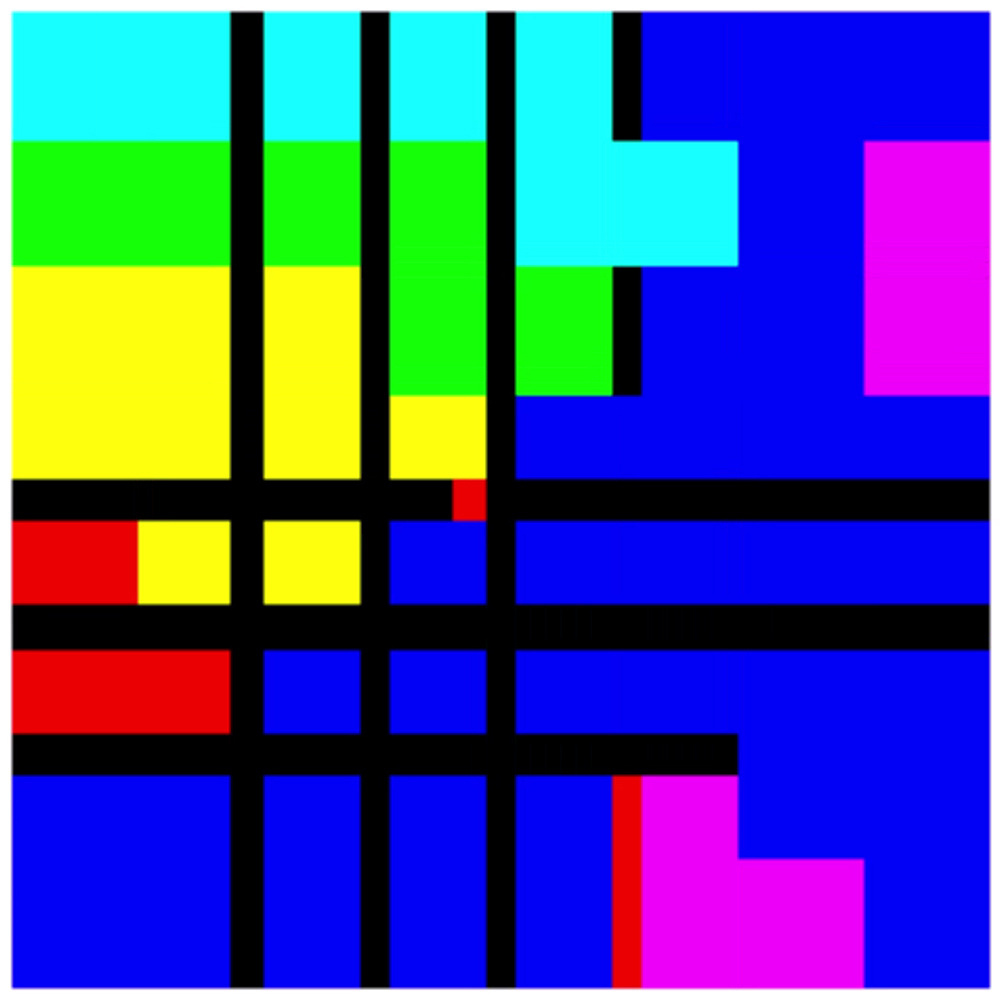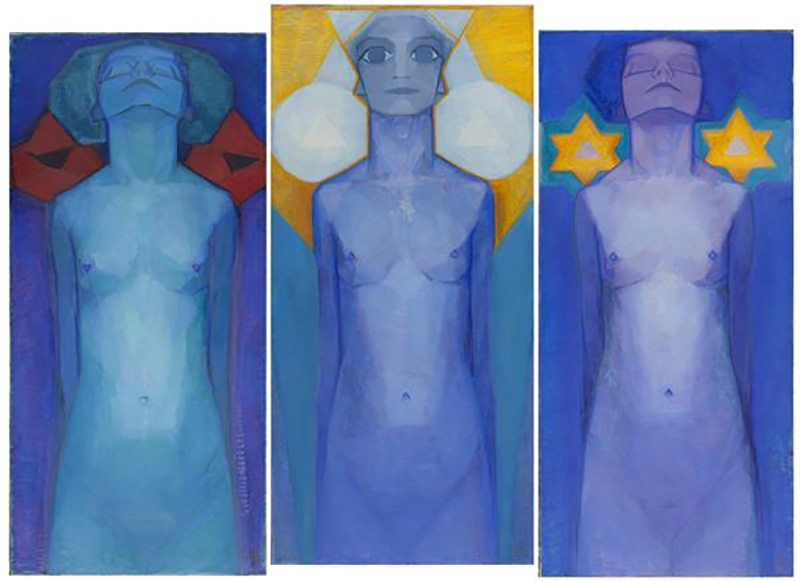IT 04: Boogie Woogie, on chance and perception (EN)
Date X., one encounters stranger than fiction. It all took place at a small farm in the outback. The chance meeting was between H. S. Occult, a retired American military who had written Sorgho & Imphee (aka sugar cane), and a middle-aged wandering Russian vagabond. Both had been drawn to the farm by reports of drifting ghostly shadows. Their meeting marked the beginning of a bizarre and unlikely partnership that yielded the major esoteric revival of modern times.

A year on from their 1st encounter, and almost by accident, H. & H. found the Secret Society in a New York apartment. Although Occult took the seat of president, it was Helena's personality that dominated the organisation, confusing facts with fiction.
Helena: “I rode bareback in a circus, toured Serbia as a concert pianist, opened an ink factory in Odessa, traded as an importer of ostrich feathers in Paris, and worked as an interior decorator for Empress Eugenie. I met the Red Indians in Canada, fought with Garibaldi's army in the Battle of Mentana, shipwreck off the Greek coast at Spetsai, and dealt with kabbalists in Egypt, secret agents in Central Asia, voodoo magicians in New Orleans and banditos in Mexico.”
But the central event of her ' Wanderjahre' was a meeting with a dematerialising Tibetan Monk called Master Morya {M. M.}. It was this encounter that alerted Helena to the existence of the 'Secret Doctrine', which was the key to the truth of life itself. Who better to mediate this wisdom to the world than Helena herself? Synthesising oriental religion, Western magic, Asian scripture and Kabbalistic, Masonic and Templar mythology, she charged her followers with the duty of collecting and interfering with the 'knowledge of the laws which govern the universe'.
Overcoming Modernism

“The artist shows the future, long before everybody else sees it.”
Constrained, calculated, deceivingly rational – Piet Mondriaan's horizontals and verticals, his planes, squares, and grids show an artist committed to exploring the parameters of perception and meaning. From Naturalism into Impressionism to Cubism, the arrival at a grammar of 'abstraction-total' . Mondrian is represented as a pivotal figure in the unfolding story of Modernism.
But while Mondriaan is promoted as the ideal Model Modernist, one astonishing fact is deliberately underexposed: Mondrian was a Theosophist. Piet was influenced by Helena's imaginational leaps, and he was fascinated by her monumentally opaque tome, 'Secret Doctrine' , a work in two volumes that Blavatsky claimed contained the key to all knowledge.
In other words, while Mondrian was straining for an art that broke completely with the artistic tradition of its times, he was seeking into spiritualism; fishing for ancient forgotten knowledge, and he was not alone in his quest. Some of the greatest artists and writers were steeped in the magic and mysteries of the occult. There was plenty of it on offer, as the new century broke into its stride.
After Darwin had given the world his theory of evolution, it took a lot of faith still to believe the world had been created in six days. Nietzsche had conceptualized that God as an individual entity didn't exist after all, and Freud was pressing enormous powers on identity and the ego. These revelations, coupled with revolutionary breakthroughs in science and technology, produced a crisis in conventional belief systems. The Christian church saw congregations shrinking as people looked elsewhere for answers to the new and totally absorbing set of questions that the modern age posed.
Kandinsky: “Everything was soft, uncertain, vacillating. It would not have astonished me to see a stone melt in the air and evaporate. Suddenly thick walls crumbled.”

Kandinsky, Paul Gauguin, Constantin Brancusi, Theo van Doesburg, Johannes Itten, Walter Gropius (for a while), Robert Delauney, Aleksandr Scriabin, František Kupka, Arnold Schoenberg, Paul Klee, Franz Marc, Boris Pasternak, Aleksandr Blok, Katharine Mansfield, T. S. Eliot - all were great pioneers of Modernism, and all were involved in Theosophy and its unpronounceable spin-offs, such as Anthroposophy.
In fact, from fin de siècle Paris to 1950s' New York; Rothko, Pollock, Newman were all heavily by Eastern spiritual teachings. A fascination with magic, the occult and the supernatural were integral to the Modernist spirit.
Mondriaan's Triptych

The idea that Modernism embodies a formal relationship with Theosophy is of no interest to critics. As its texts are largely indecipherable, Madame B. (aka Koot Hoom La, Mahatma Morya) is widely considered a charlatan. Nevertheless, the link does exist, and it collides with the conventional history of Modernism. Many art-historians flinch at the idea this strangely looking woman was the spring of the Modern avant-garde movement.
Crit.: “The central claim of Modernism is that it pushes forward, by completely rupturing with the past.”
Significantly, key historians play down Mondrian's association with Theosophy. The matter receives only a glancing mention, where it is treated as a kind of foolish period which Mondrian later recovered from.
†: “In the New York apartment of Mondrian we only found 7 books, all of them theosophical.”

His explicitly Theosophical contribution is a triptych called Evolution (1919) [Triptychon : A pictorial representation consisting of a central image and two movable wings, a painted or carved three-part winged altar]. Three large panels show the figure of a woman in different states of consciousness.
Painted with deep blueish colours and punctuated with starry symbols {*}, three times the same symmetrical figure, a synthesising trinity, left and right resting, the middle slightly higher with enlightened open eyes.
If this is what Theosophy brought him, it's understandable that scholars and critics want to side-step the issue. But the steps that took Mondrian to paint this triptych were to take him much further.
Appearance & Reality

Moonen : “Abstraction is not about making pretty patterns. It is a quest into a level of reality higher than the merely material.”
Mondrian had been a member of the Theosophical Society for 3 years when he painted Evolution. He had joined in 1909, after spending a summer in Domburg (NL), a retreat favoured by avant-garde spiritualists.
Mondrian: “Through Theosophy I became aware that art could provide a transition to the finer regions, which I will call the spiritual realm.”
Mondrian - and many other so-called Modernists - believed that art could change the conditions of human life. He saw art not as an end but a path of spiritual clarification. It soon became clear that traditional ways of seeing the world would not satisfy this imperative. Artists now understood that the key to understanding the universe could not be found just by looking at shadow-play on ordinary day-to-day matter.

Brancusi: “What is real is not the external form, but the essence of things. It is impossible for anyone to express anything essentially real by imitating its exterior surface.”
This was the key to abstraction, which began to emerge around 1910, it was also the key to Theosophy. Both emerged themselves with investigating the process of cosmic and human evolution, with finding the 'essence of things'. Both looked for a universal grammar that could communicate this essence:
· instinctively drawn into the ancient philosophical and religious controversy concerning the relationship of appearance and reality.
· anti-conceptual: the belief that one could understand emotionally the secrets of creation in a way that transcended scientific observation or sheer logic.
Wassily Kandinsky in Germany, František Kupka in Czechoslovakia, Kazimir Malevich and others of his circle in Russia, Piet Mondriaan in the Netherlands - all now moved away from representational art towards the creation of 'abstraction-total' that embodied their involvement with esoteric thought. They replaced natural colour with symbolic colour, perceived reality with signs, direct observation with ideas.

Our minds are infected with unbelief, of lack of purpose and ideal. The nightmare of materialism which has turned our daily lives into a useless game is not yet past; it holds our encapsulated modernist soul still in its grip. Every person who steers himself in the spiritual possibilities of his art is a valuable helper in the building of the pyramid which will one day reach into the skies.
IT 04: Boogie Woogie, on chance and perception writer remains unknown, cut and corrected by M. Moonen 10.2021 [EDUCATIONAL PURPOSE ONLY] Triple-A Society, M. Production